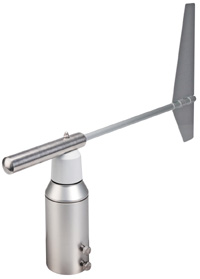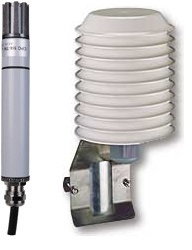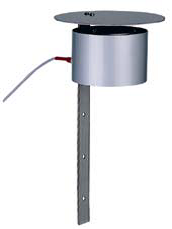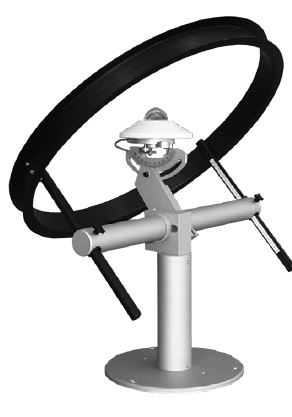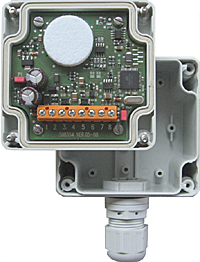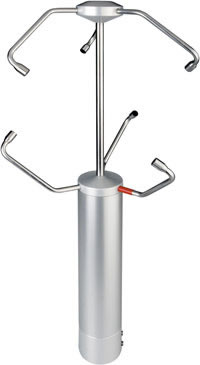ASU Weather Station
The ASU Weather Station is the first of its kind in Jordanian universities, installed in May 2015 to provide weather data for researchers inside and outside the university, and to assist weather forecasting in the locations around ASU in the future. The ASU Weather Station is 36 meter high and equipped with 10 measuring instrument, measuring the following atmospheric conditions:
|
1. Wind speed (at levels of 36, 35, 33 and 10m) 2. Wind direction (at levels of 35, 33, and 10m) 3. Ambient Temperature (at levels of 35, 33 and 1m) 4. Relative Humidity (at levels of 35 and 1m) 5. Barometric pressure |
6. Precipitation amounts 7. Solar Irradiance 8. Solar Irradiance 9. Soil Surface Temperature 10. Subsoil Temperature |
Below is a real-time data for ASU Weather Station upated every one minute. Click image to see full size.
List of instruments :-
|
1. Wind Speed Transmitter
The wind speed transmitter measures the horizontal component of the wind speed, it is one of the most important measuring devices in weather stations. The measured value is available in digital form so it can recorded and monitored easily. The wind transmitter is equipped with an electronically regulated heating to provide a smooth running of ball bearings during winter operations, and to prevent the shaft and slot from icing-up. It measures the wind speed higher than 0.3 m/s and up to 75 m/s with accuracy of 1% of the measured value. The top highest wind transmitter is equipped with Aluminum lightening rod, to protect the structure of the weather station in the event of lightning strike.e wind speed transmitter measures the horizontal component of the wind speed, it is one of the most important measuring devices in weather stations. The measured value is available in digital form so it can recorded and monitored easily. The wind transmitter is equipped with an electronically regulated heating to provide a smooth running of ball bearings during winter operations, and to prevent the shaft and slot from icing-up. It measures the wind speed higher than 0.3 m/s and up to 75 m/s with accuracy of 1% of the measured value. The top highest wind transmitter is equipped with Aluminum lightening rod, to protect the structure of the weather station in the event of lightning strike. |
|
|
2. Wind Direction Transmitter
The wind direction sensor measures the direction of horizontal air flow. It is potentiometer wind direction sensor which equipped with sliding potentiometer that offers high level of measuring accuracy and resolution. The wind direction sensor is characterized by: • High damping ratio at small delay distance. • Low starting threshold. • Low current consumption (3.3V @ 1.4mA). • Easy removal and mounting when replacing the ball bearings.
Measuring range of the wind direction sensor is one full revolution (0 to 360°), with 0.5° measuring accuracy and survival speed of 85 m/s up to 30 minutes. |
|
|
3. Hygro-Thermo Transmitter with Weather and Thermal Radiation Shield.
The Hygro-Thermo Transmitter measures the relative humidity and temperature of ambient air, it utilizes capacities sensing element to measure the relative humidity and RTD to measure the temperature. Humidity measuring range is from 0 to 100% with ± 2% deviation and for temperature is from -30 to 70°C with ± 0.2 K deviation. Both solar radiation and precipitation can adversely affect the accuracy of measured data if the humidity and temperature sensors are not protected. Moreover, unprotected sensors increases the risk of mechanical damage. The Weather and Thermal Radiation Shield is designed to protect humidity and temperature sensors against radiation, precipitation and mechanical damage. More exact measurements are achieved by using ventilated shield for sensors. The ventilation reduces those errors which might occur during the measurements in non-ventilated locations. |
|
|
4. Temperature Transmitter
The Temperature Transmitter is designed for measuring the soil temperature in different depths. The soil temperature measurement sensor in ASU Weather Station is installed at 6m depth. The sensor is Pt 100-resistance thermometer enclosed built-in a stainless steel tube. The measuring range is from -30 to 100°C with 0.1°C accuracy at 0°C. |
|
|
5.Earth Surface Temperature Transmitter.
The Earth Surface Temperature Transmitterhe Earth Surface Temperature Transmitter measures the temperature at ground level and it is combined with data logger or a measuring transducer and display or recording instrument, hence it represents a complete temperature measurement system. One important are of application is the determination of ground frost to make it possible to protect temperature-sensitive plants before damage can occur. Another important application is for traffic warnings concerning ice and sleet formation on roads and highways. The measuring element is Pt 100-resistance thermometer with -30 to +50°C and ±0.1 K accuracy at 0°C |
|
|
6.Pyranometer and Pyranometer with Shadow Ring.
Solar radiation is one of the most important meteorological date that could be measured since it affects almost every dynamic process in the Earth's surface and above. Wind is a result of temperature difference in the atmosphere induced by solar irradiation, waves are generated by the wind, clouds and rain are initially formed by the evaporation of water due to sunlight. The measurement of solar radiation is made by pyranometers, which are radiometers designed for measuring the total (global) irradiance on a plane surface resulting from radiant fluxes in the wavelength range from 300 nanometers (nm), or less, to 3000 nm. ASU Weather Station pyranometer have the following specifications: • Spectral range: 285 to 2800nm • Sensitivity: 7 to 14µV/W/m2 • Maximum Operational Irradiance: 4000W/m2 • Operational Temperature range: -40°C to +80 • Detector type: Thermopile The combination of shadow ring and a pyranometer offers a simple solution for the measurement of the diffuse solar radiation. The shadow ring is regularly adjusted to keep the pyranometer in the shade during all the year, preventing direct solar radiation to reach the sensor |
|
|
7.Precipitation Transmitter
The instrument is designed to measure the height, quantity and the intensity of the precipitation striking the surface of the earth. The measuring principle is based on the description "Guide to Meteorological Instruments No 8" of the WMO (World Meteorological Organization). The precipitation collected by the collecting surface of 200 cm2, is conducted through a inflow-sieve into a tipping-bucket. After having collected the precipitation amount of 2 cm3 = 0.1 mm of precipitation the bucket tips over, and the other tipping-bucket halve is ready for collecting the rain. This tipping procedure is detected by Hal-Sensors, and induces an output pulse in combination with connected electronics. The procedure recur with continuous precipitation. The measuring range of the precipitation transmitter is from 0 to 11 mm/min with ±3% accuracy. |
|
|
8. Baro Transmitter.
The Baro Transmitter measures the Absolute Air Pressure at the location or calculates the Reduced Air Pressure with respectively reduced altitude (referring to sea level). It is designed for application in the field of environmental protection, where high accuracy, quick responding behavior, long-term stability and reliability are required. The instrument is suited for indoor- and field application. A tempered piezoceramic sensor for absolute pressure is used, which is characterized by thermal and mechanical stability. The Baro Transmitter measuring range is from 300 to 1100 hPa with 0.01 hPa resolution |
|
|
9. Ultrasonic Anemometer 3D
The Ultrasonic Anemometer 3D serves for the measurement of the horizontal and vertical components of wind direction, wind velocity and acoustic virtual temperature from all spatial directions. More than 70 different measurement values are available, such as: • Wind velocity in X/Y/Z-directions • Total wind velocity • Wind velocity azimuth • Wind direction azimuth • Wind direction elevation • Standard deviation of wind velocity in X/Y/Z-directions • Wind velocity in X/Y/Z-directions of the gust acceleration • Turbulence intensity in X/Y/Z-directions The device is suited for use in the fields of meteorology, climatology, indoor flow measurement as well as for aviation and navigation. The measuring range for wind velocity is from 0.01 to 99.99 m/s with up to 0.01 m/s resolution. For wind direction the measuring range is from 0 to 360° azimuth and -90 to +90° elevation, with up to 0.1° resolution. |
|


